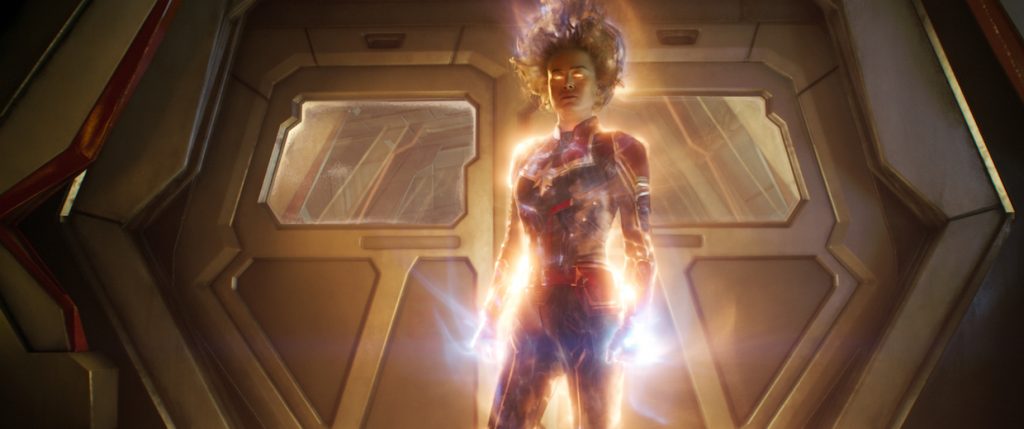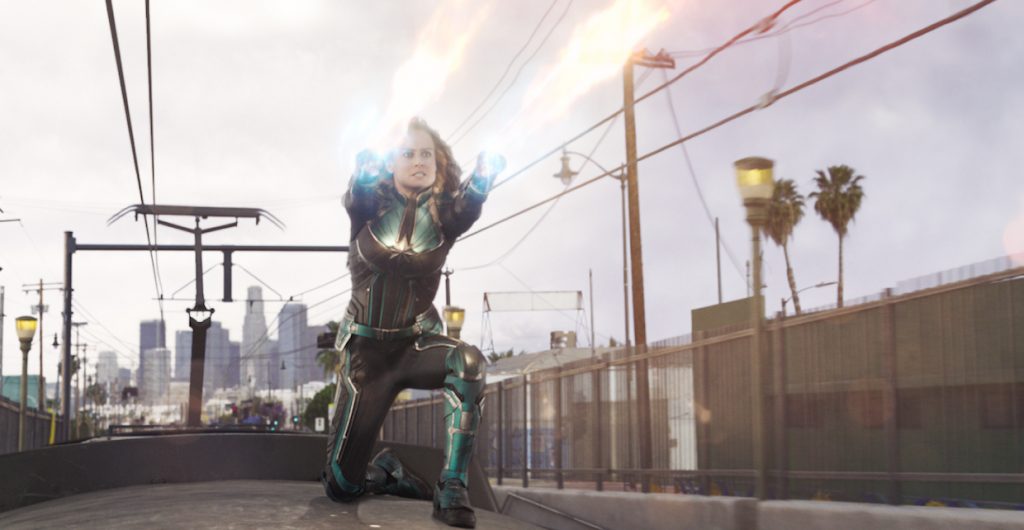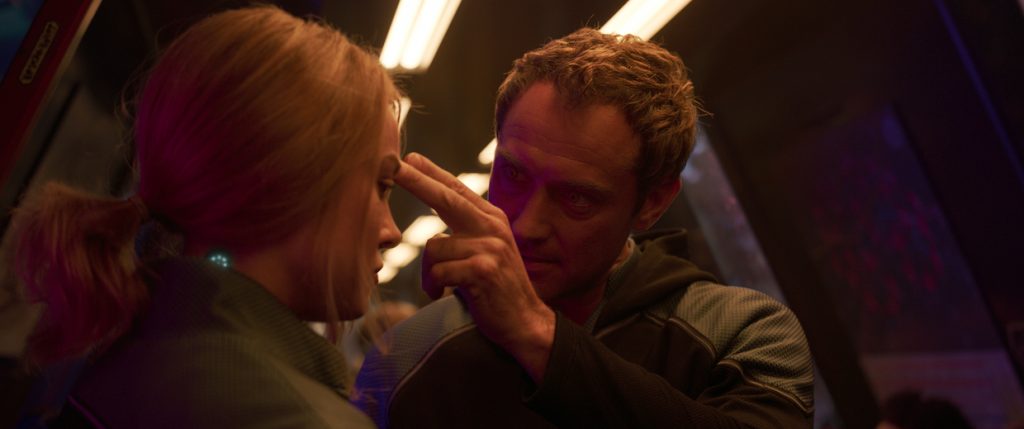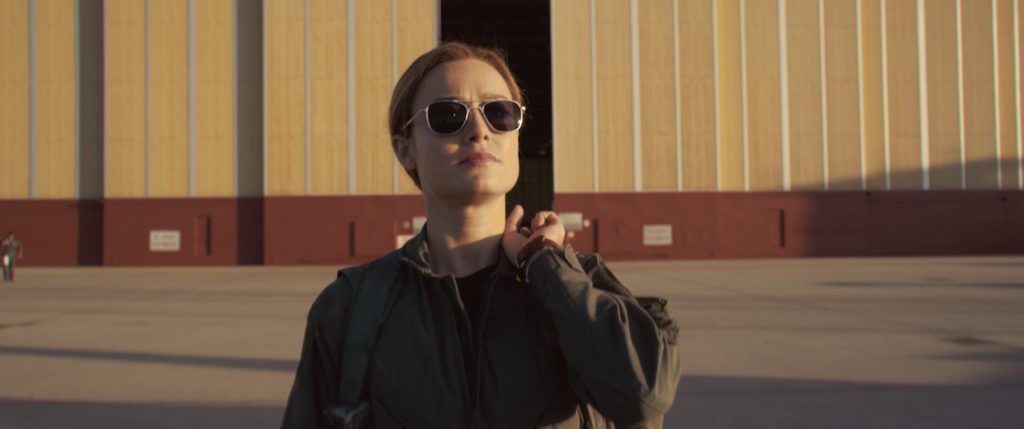 Back to selection
Back to selection
Shutter Angles
Conversations with DPs, directors and below-the-line crew by Matt Mulcahey
“The Weather Doesn’t Care What Your Budget Is”: Captain Marvel Colorist Doug Delaney on the Marvel Cinematic Universe
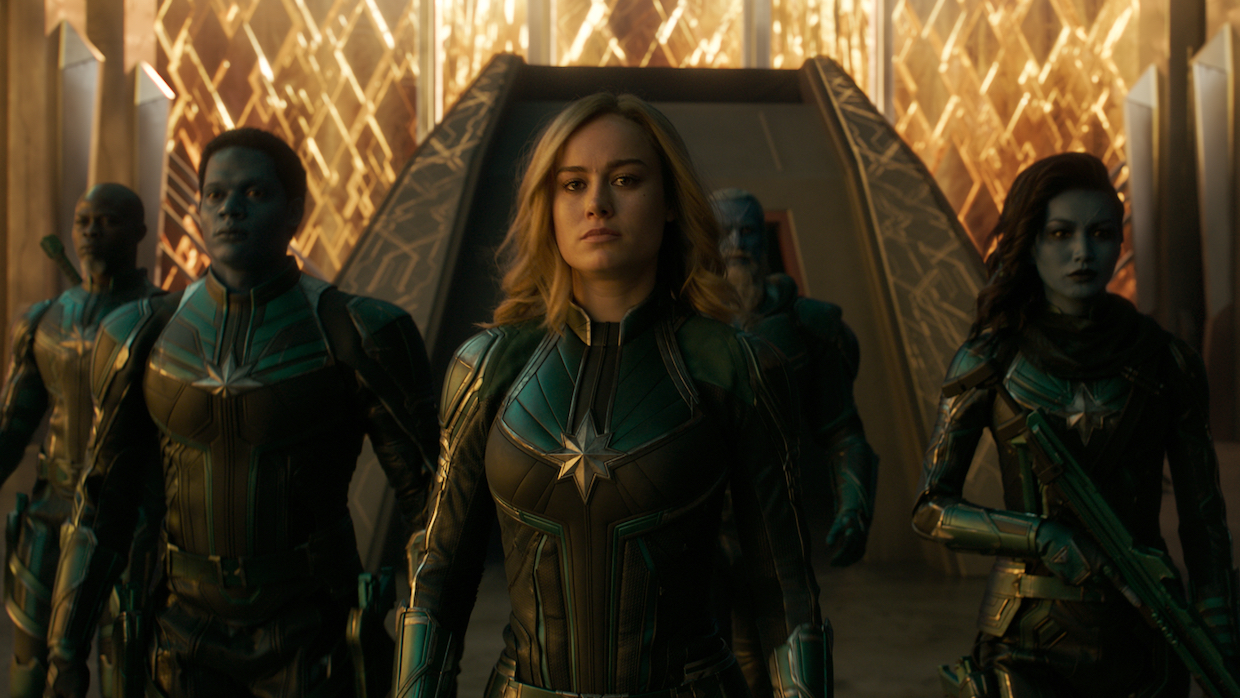 Brie Larson (center) in Captain Marvel
Brie Larson (center) in Captain Marvel When Avengers: Endgame hits theaters in a few weeks, it will conclude a chapter in the Marvel Cinematic Universe that encompasses 22 films over more than a decade. Considering the disparate tones, settings and filmmakers involved in the “Infinity Saga,” the fact that the movies fit so seamlessly together and have been so consistently entertaining is a remarkable achievement. Part of the magic trick of integrating the superhero adventures into a cohesive whole comes from the work of colorists, who have been entrusted with ensuring the Tesseract glows the same shade of blue whether it appears in Thor, Infinity War or the latest entry, Captain Marvel.
Set in the 1990s, Captain Marvel stars Brie Larson as Carol Danvers, a test pilot imbued with superhuman powers who teams up with a de-aged Nick Fury to battle a race of shape-shifting aliens known as the Skrull. The task of making Larson’s suit just the right hue of red, gold and blue fell to Technicolor senior colorist Doug Delaney, who talked to Filmmaker about the distinct workflow of tentpole blockbusters.
Filmmaker: Looking over your credits, you started in the late 1990s as a “scanning and recording” technician. What was that job?
Delaney: That was my entrance into the field, which was before digital intermediates even existed. Back then, [for shots incorporating visual effects] you had to scan the camera original negative on a scanner and digitize it. The visual effect would be executed, then you’d have to record that digital file back onto a piece of negative film and process it at the lab. That’s how I started in color timing, because in those days the scanners, which were essentially like digital cameras jury rigged on an old optical printer, couldn’t capture the full dynamic range of film. So you had to do the exposure at the point of scan and try to accurately reproduce the director of photography’s intent, so that when it went to the visual effects artist it was already in a pretty good place. Then when you recorded that digital file back out you would compare your recorded out version against the original version and try to get them as close as possible to each other so the round trip was seamless and the audience hopefully couldn’t tell the difference.
I started doing that as a technician and then got into supervising that role. Around 2002 or 2003 I was supervising that process on the Matrix [sequels] and we decided that [instead of just scanning in the scenes needed for VFX], we’d beta test this whole digitaliIntermediate thing since there were entire sequences in those movies that were visual effects. That’s how I officially got into doing DIs.
Filmmaker: How much different was the DI process in those early days?
Delaney: It was very bulky and difficult. Now we’re doing it on our laptops. (laughs) Back in those days that was certainly not the case. It would take 15 seconds a frame to scan a 2K piece of negative. Imagine doing that for the whole movie. In those days, (recording back out to film) would take you 20-something hours per reel. A typical movie is maybe six or seven reels. If you got to the end and there was an issue, you had to start all over again. It was a painful process for sure. I’m grateful for the experience and discipline I learned from it, but I don’t miss it.
Filmmaker: When you’re coloring a move in the Marvel Cinematic Universe, what are the rules you have to adhere to so that it fits seamlessly into that world?
Delaney: Marvel is very particular about the color of certain things. The green of the Kree uniforms in Captain Marvel is a very particular green. The blue, gold and red of the Captain Marvel suit are very particular colors. The Tesseract is a very particular color. Maintaining the consistency of those colors is an important part of the job.
Filmmaker: Because fans would notice if it was off—probably in a very vocal way.
Delaney: Yes, exactly. So you have a responsibility to maintain that, which I think is unique for these types of movies—being conscious of that branding, as well as the look development of the film itself.
Filmmaker: Captain Marvel is the fourth Marvel movie for cinematographer Ben Davis, so I’m assuming he has the workflow down for a big effects film like this. Is he someone who likes to create overall show LUTs?
Delaney: Marvel actually handles a lot of that internally and develop show LUTs specifically for each of their films. For Captain Marvel they worked in concert with our color science team here at Technicolor, but a lot of the work is done internally at Marvel. So there’s typically a show LUT, and then CDL information created by the DIT and the dailies colorist that goes along with it. Those travel to the VFX people as well.
Filmmaker: When you first get your hands on the footage to begin work, it’s coming along with those LUTs and CDLs. Do you go back to the Raw camera files and start from scratch, or are you applying the LUTs and the CDLs and beginning your work from there?
Delaney: The show LUT gets applied for sure, and typically the CDLs as well. You’ve sat through the credits on these movies, right? The credits crawl lasts for ten minutes. It’s literally hundreds of people from different VFX [vendors]. For everyone to be speaking the same language and looking at the same thing, those CDLs and show LUTs have to be distributed and applied for everybody—literally people all over the world. So, I have to adhere to the same color pipeline as everybody else has, because that’s how everyone’s been looking at the footage, giving notes on it and ultimately approving all of these [VFX] shots. By the time it comes to me there’s not a lot of wiggle room to say “Let’s crack our knuckles and try something totally different.” We do end up taking a few left turns here and there, but only when it’s appropriate and when there’s buy-in from everyone from the VFX supervisor to the director to the DP.
Filmmaker: When you first start work, how much of the VFX are finished?
Delaney: It varies from show to show. We usually talk about it in terms of percentage completion per reel. It could be anywhere from 50 percent to 80 percent complete and the rest are either temps or works in progress or nothing, like just the plates. On Captain Marvel it was between 60 and 80 percent complete when we started, probably closer to 60 percent.
Before we even start work, we’ll all sit down with the directors, the Marvel creative people and the VFX people and we’ll watch the movie in its current state, projected out of the Avid, so we can all wrap our heads around what the movie is going to be and where it’s going to go. Then, to start work, we’ll find the sequences that are the most complete and begin with those. It’s a very unique way of working. The reel that’s the most complete might be reel four instead of reel one—though it’s usually not a reel from the third act, because the finales are typically these big visual effects extravaganzas and those are normally coming in hot and heavy at the very, very end. But we’ll do a scene here, a scene there, maybe a couple of shots from another scene. So you’re never really completing a reel at any given time. You’re always jumping around and filling things in as they come.
© 2019 MARVEL
Filmmaker: Let’s look at some frames from the movie. The first one is a shot of Captain Marvel in full glowing superhero mode.
Delaney: As I said, Marvel is very particular about things like the quality , the amount and the color of the glow. Those things are very important and when you’re grading sequences you have to be a good steward of that. Your role becomes more about continuity from shot to shot and then also shepherding through the various deliverables like EDR (Extended Dynamic Range), HDR (High Dynamic Range) and stereo 3D. There’s careful consideration of contrast and color saturation that you have to maintain through all of those deliverables. And then occasionally in the grade we’re adding interactive lighting. So, in the reverse of this shot I think it cuts to Nick Fury and [Carol’s friend and fellow pilot] Maria, and in the grade we added some interactive lighting just to make the scene work more smoothly from cut to cut.
Filmmaker: How different are all those deliverables from version to version?
Delaney: Because the suit color and the amount of detail in the glow and all these things are so important, that has to be maintained throughout all the different deliverables and across all the different light levels and color spaces and Nit values. So when you move into EDR or HDR, while you want to leverage the ability [of that technology], the big challenge is making all these versions feel the same. You don’t want to say, “Now we’re in HDR, let’s make everything bright and super crazy.” You want it to feel like the same movie [regardless of the viewing platform].
With a movie of this scale, you’re finishing the film literally weeks before it’s released. That release is international and standard projection, plus Dolby Vision projection, plus stereo 3D in various forms, plus IMAX. It’s a huge amount of work. The compression of time on these kinds of films is quite intense and it really is impossible to do without collaborative workflows. I had a second colorist helping me and two additional people helping on rotoscopingand tracking and doing the 3D stereo grade. Some of those people were also helping with the IMAX version plus additional help on the home video version, because they’re releasing online very close to the [theatrical] release date of the film.
© 2019 MARVEL
Filmmaker: Next, let’s do an action scene. Here’s a frame from a set piece where Danvers chases one of the shape-shifting Skrulls on the top of a train.
Delaney: They shot that sequence over the course of ten days, so the weather from day to day was all over the place, even from hour to hour. Getting that to be consistent was one of the more challenging sequences on this film. It’s all day exteriors, it’s all [incorporating] visual effects and the color temperature of the sky was all over the place. Visual effects did a lot of work to get that more cohesive, but in the grade we took it to the finish by evening it out with color and sky grads, a lot of keys and rotoscoping to control the backgrounds and get them more consistent. At times, we were also taking away light and adding shadows and suggesting that the sun is brighter—not by making something in the frame brighter but actually by making part of the frame darker.
© 2019 MARVEL
Filmmaker: The movie opens on the Kree planet of Hala, where we first meet Brie’s character. The shot above is on a train after she has finished a training session with her mentor, played by Jude Law.
Delaney: That’s definitely a sequence that was very colorful and pushed the gamut of what you can project and what you can display. Balancing the color and contrast of that scene—which is very vivid and very heightened, yet the scene is very intimate—was a challenge. We did a lot of work controlling the background in that scene, not just out the window but also those lights behind Law’s character so they didn’t pull attention away from the actors.
Filmmaker: Now that RGB LED lights let cinematographers so easily add color, have you noticed any difference on your end of things?
Delaney: Well, any of these tools are just that—tools. When used appropriately and well, it makes things much more consistent, and therefore much easier come the time of the grade. When it’s a DP who’s really well-versed and comfortable with that technology, it has been amazing. That’s one of the biggest changes in production technology, as much if not more so than camera technology, and that’s not something that’s talked about very much. We’re always talking about “How many K’s is your camera?”
© 2019 MARVEL
Filmmaker: The last frame is from the section of the film set in the ’90s on Earth. This is a flashback from Carol’s pre-Captain Marvel days as a test pilot.
Delaney: That was another pretty challenging sequence. It’s a short scene, but an important one. When we cut to the reverse from behind her, it was shot at a slightly different time of day. So in the [frame above[ there’s these slashes of shadows in the background and on the reverse none of that existed, so we had to add them in the grade through rotoscoping and tracking and all these different grading techniques. Then we cut to another wide high shot where we had to do the same thing to make the cuts match. That was a brief sequence, but it was a good amount of work.
Filmmaker: One thing I can never seem to get quite right is making a drab, overcast day look bright and warm. It always ends up looking like I just pushed a bunch of orange into the midtones and highlights. Is there any particular grading situation that is your nemesis?
Delaney: It’s interesting—with this type of film, everything is done at such a high level. The photography is really good and really consistent. The visual effects are tremendous. On a movie like Captain Marvel, everybody in every department is A-game. But even then, every production has challenges regardless of the budget. When you’re shooting outside, the weather doesn’t care what your budget is. The sun is going to set at the same time whether you have $100 million or $100,000. We had a few scenes in Captain Marvel that required that I leverage a great deal of grading techniques to get to where the scenes needed to be as a result of challenging production situations. I work on many types of films and shows and the expected result is the same whether it’s a Marvel movie or an indie. But that’s okay, that’s what we do as colorists. The audience doesn’t care what the budget was or how many hours you spent on the grade. They just want to see a good movie.
Matt Mulcahey works as a DIT in the Midwest. He also writes about film on his blog Deep Fried Movies.
